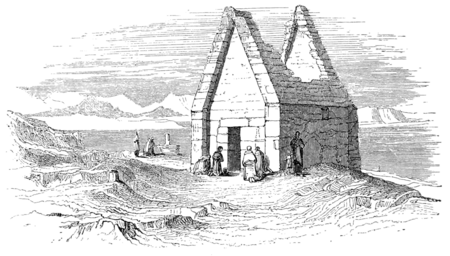Cyclopean, the stones being throughout of great size, and one of them not less than eighteen feet in length,—which is the entire external breadth of the church,—and three feet in thickness.
"The ancient churches are not, however, always so wholly unadorned: in many instances they present flat rectangular projections, or pilasters, of plain masonry at all their angles; and these projections are, in some instances, carried up from the perpendicular angles along the faces of the gables to the very apex, as appears in the annexed engraving of St. Mac Dara's church, on the island of Cruach Mhic Dara, off the coast of Connamara:
"This little church is, in its internal measurement, but fifteen feet in length, and eleven feet in breadth; and its walls, which are two feet eight inches in thickness, are built, like those of the church of St. Ceannanach already described, of stones of great size, and its roof of the same material. The circular stone house of this saint, built in the same style but without cement, still remains, but greatly dilapidated: it is an oval of twenty-four feet by eighteen, and the walls are seven feet in thickness." p. 186.
One remarkable peculiarity will be observed in the greater part of the doorways in these ancient structures, they are built after the Egyptian fashion, narrower at the top than at the bottom : this peculiarity of construction Mr. Petrie considers as evidence of the very high antiquity of the structures in which it occurs, and he labours with much ingenuity to prove that the ornaments upon them are of earlier character than the twelfth century, the period to which he evidently feels that they would naturally be assigned. Without entering into this controversy, it may be observed that this peculiarity scarcely amounts to more than one of those provincialisms which we find prevailing in so many other instances, such as the churches near the Rhine, which were long supposed to belong to

